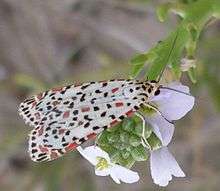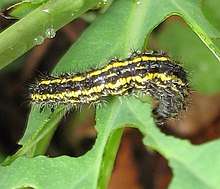Callimorphina
The Callimorphina are a subtribe of woolly bear moths in the family Erebidae. The subtribe was described by Francis Walker in 1865. Many of these moths are easily confused with butterflies, being quite brightly colored and somewhat diurnal. Their antennae are not thickened into "clubs", which is a typical characteristic of butterflies.
| Callimorphina | |
|---|---|
 | |
| Utetheisa pulchelloides imago | |
| Scientific classification | |
| Kingdom: | Animalia |
| Phylum: | Arthropoda |
| Class: | Insecta |
| Order: | Lepidoptera |
| Superfamily: | Noctuoidea |
| Family: | Erebidae |
| Subfamily: | Arctiinae |
| Tribe: | Arctiini |
| Subtribe: | Callimorphina Walker, [1865] |
| Synonyms | |
| |

Haploa sp. caterpillar on bluebells
Genera
This list of genera in the subtribe were outlined by Michelle A. DaCosta and Susan J. Weller[1] and by Vladimir Viktorovitch Dubatolov.[2]
gollark: https://images.anandtech.com/doci/10375/4.%20Tech%20Day%20Bifrost%20FINAL-34_575px.png
gollark: This is LyricLy right now:
gollark: I think it is, but my memory is bad too.
gollark: But is it a decompressor?
gollark: It's not my fault if I can't read.
References
- DaCosta MA, Weller SJ (2005) Phylogeny and classification of Callimorphini (Lepidoptera: Arctiidae: Arctiinae). Zootaxa 1025:1-94
- Dubatolov VV (2006): Cladogenesis of tiger-moths of the subfamily Arctiinae: development of a cladogenetic model of the tribe Callimorphini (Lepidoptera, Arctiidae) by the SYNAP method. Euroasian Entomological Journal 5(2):95-104 (in Russian)
This article is issued from Wikipedia. The text is licensed under Creative Commons - Attribution - Sharealike. Additional terms may apply for the media files.